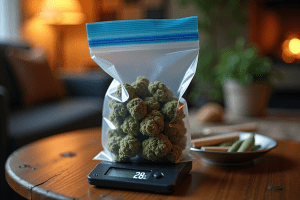Overview
The term “zip of weed” refers to an ounce, which is approximately 28 grams, of marijuana flower. This term is commonly used in transactions within the cannabis community and likely derives from the Ziploc bags that have traditionally been used for packaging. Understanding this measurement is essential for consumers, as it helps them navigate pricing effectively.
Prices can vary significantly, ranging from $150 to $350. These variations are influenced by factors such as quality, location, and market demand. By grasping these details, you can make more informed purchasing decisions and feel more confident in your choices.
Introduction
In the evolving landscape of cannabis culture, understanding the terminology is essential for all of us—whether you’re just starting out or have been part of this vibrant community for a while. One term that often comes up is “zip of weed,” which represents one ounce—or approximately 28 grams—of cannabis flower. This measurement plays a crucial role in both legal and illicit transactions, serving as a helpful guide for navigating the complexities of the cannabis market.
As we explore the varying prices influenced by quality, location, and market dynamics, it’s important to grasp the nuances of what a zip entails. This understanding can significantly enhance your purchasing experience. From the origins of the term rooted in discreet packaging to the implications of strain quality and cultivation methods, diving into the world of zips offers valuable insights. Together, we can empower ourselves to make informed choices that enrich our cannabis journey.
Define ‘Zip of Weed’: A Comprehensive Overview
The term ‘zip of weed’ is recognized by many in the marijuana community, referring to an ounce of marijuana flower, which is approximately 28 grams. Understanding this measurement is essential for consumers, as it is commonly used in transactions that may involve a zip of weed, whether legal or illicit. The term ‘zip of weed’ likely comes from the use of Ziploc bags, which provide a discreet and convenient way to transport an ounce of marijuana. Grasping the concept of a zip of weed helps us navigate the marijuana market, as it represents a standard quantity often found in dispensaries.
Other common measurements include:
- grams
- eighths
- quarters
- half ounces
- pounds
- quarter pounds
These provide a broader context for understanding a zip of weed. The price of a zip of weed can vary significantly, typically ranging from $150 to $350, influenced by factors such as quality, location, and market dynamics. For instance, in California, taxes can add as much as 35% to the cost of marijuana products, affecting our choices as consumers. However, obtaining a medical marijuana card can lead to savings of upwards of 10%, as cardholders often benefit from tax exemptions, making products like a zip of weed more affordable, with several factors such as strain quality, seasonal availability, and local demand playing a crucial role in determining its price.
New marijuana users should familiarize themselves with the types of outlets available. Medical outlets cater to patients with valid medical cards, offering products tailored for specific health conditions. In contrast, recreational outlets serve adults aged 21 and over without requiring a medical card. Medical dispensaries typically provide a wider range of therapeutic products, while recreational dispensaries focus on items for enjoyment.
Dispensaries offer a variety of marijuana products, including:
- flower (buds)
- edibles (like gummies, chocolates, and beverages)
- concentrates (such as shatter, wax, and oils)
- vape cartridges
- topicals (like creams, balms, and lotions)
- tinctures
Case studies show that new marijuana consumers often learn about measurements like the zip through direct experience and education. As Ukeme Akpan notes, ‘I have been researching and writing topics related to medical marijuana for many years. My goal is to create educational content.’ By understanding what a zip of weed means, we can make informed purchasing decisions, which enhances our overall experience with the product. It’s important to start with a low dose and gradually increase as needed, always consuming marijuana products responsibly and being aware of local laws regarding use and possession.
Trace the Origin of ‘Zip’: Historical Context and Cultural Significance
The term ‘zip’ has its roots in the marijuana black market, where discretion was crucial for users. It’s believed that this term emerged in the 1970s, aligning with the practice of selling marijuana in small plastic bags, particularly Ziploc bags. This method allowed for simple and discreet transport of the product.
As the marijuana industry evolved and legalization spread, ‘zip’ became a familiar term among marijuana users. It signifies not only a specific quantity but also embodies a cultural identity within the marijuana community, representing a shared understanding and experiences among users.
At Leafy Mate, we recognize the cultural significance of terms such as ‘zip of weed.’ We aim to empower new users with the information they need to navigate the market effectively. We connect you with trusted dispensaries and medical marijuana doctors, ensuring you have access to the best resources available.
When choosing your zip, it’s also important to consider both price and quality to maximize your value. Did you know that properly cured marijuana can be stored for up to one year without losing significant potency and quality? This is crucial for consumers, as different consumption methods—such as smoking, vaping, or eating edibles—can influence the duration and intensity of the high experienced from a zip of weed. This allows you to tailor your consumption method to achieve your desired effects and manage your experience more effectively.
Together, let’s explore the options that best suit your needs.
Examine the Practicalities: Weight, Cost, and Comparisons to Other Measurements
In the marijuana industry, a standard measurement is a zip of weed, which is equal to one ounce (28 grams). It’s helpful to understand that 1 pound equals 16 ounces, meaning there are 16 zips in a pound of marijuana. The cost of a zip of weed can vary significantly, influenced by factors such as quality, strain, and geographical location. In 2025, the average price for a zip of weed ranges from $150 to $400, reflecting these variables.
To help you navigate this world, consider other common measurements:
- An eighth (3.5 grams)
- A quarter (7 grams)
Prices generally decrease per gram as the quantity increases. For example, an eighth might cost between $40 and $70, while a quarter typically ranges from $80 to $140. Understanding these measurements and their related costs is essential for making informed choices that align with your budget and preferences.
Additionally, the dynamics of the marijuana market, including oversupply or shortages, can further affect pricing strategies at dispensaries. By grasping these concepts, you can navigate your purchasing options more effectively. The term ‘zip of weed’ itself comes from the practice of dealers packaging marijuana in zip-lock bags, which helps to demystify terminology and contributes to a better understanding of the culture surrounding it.
It’s also noteworthy that 1 pound of marijuana is equivalent to 448 grams, which provides a clearer picture of measurements. Together, let’s explore these aspects to empower your choices in the marijuana market.
Analyze Factors Affecting Price and Quality: What Consumers Should Know
Several key factors, including strain type, cultivation methods, and market demand, influence the price and quality of a zip of weed. High-quality strains, often referred to as ‘top-shelf,’ typically command premium prices due to their superior potency and flavor profiles. Have you ever wondered what makes one strain stand out over another? A recent study involving 817 marijuana users revealed that intrinsic attributes such as quality, strain type, and THC content are prioritized over external factors like branding when making purchasing decisions. This underscores the significance of strain selection in determining value, reinforcing the necessity for purchasers to evaluate quality meticulously. Jennifer Donnan noted that quality evaluation is essential in interpreting findings related to buyer preferences, reminding us to pay attention to what truly matters.
Cultivation methods also play an essential role in shaping both quality and cost. Indoor-grown marijuana, cultivated under controlled conditions, often results in higher quality products but tends to be more expensive than outdoor or greenhouse-grown options. This is due to the increased resources and care required for indoor cultivation. Understanding the varieties of dispensaries—medical and recreational—can assist you in navigating your choices effectively. Medical dispensaries serve individuals with valid medical cards, offering products designed for specific conditions, while recreational dispensaries cater to adults aged 21 and older, providing a variety of products including flower, edibles, and concentrates.
Regional price variations can significantly impact costs, as legal markets fluctuate based on local supply and demand dynamics. For example, in South Dakota, 43.9% of voters recently opposed a proposal to legalize adult-use marijuana, which could influence local market conditions and pricing by restricting supply options and impacting access for buyers. Recognizing these factors enables you to make informed decisions and appreciate the worth of your purchases. By understanding how strain type and cultivation techniques affect pricing, you can navigate the market more effectively and choose products that align with your preferences and budget. Furthermore, the findings from the study may have implications for cannabis policy design, suggesting that consumer preferences should be considered in shaping regulations that affect market dynamics. Always remember to consume responsibly and consult with knowledgeable budtenders at dispensaries to enhance your experience, as we’re all in this journey together.
Conclusion
Understanding the concept of a “zip of weed” is essential for anyone navigating the cannabis landscape, whether you are a newcomer or a seasoned consumer. This term, denoting one ounce or approximately 28 grams of cannabis flower, serves as a cornerstone in both legal and illicit transactions within our cannabis community. Knowing this measurement and its implications can significantly enhance your purchasing decisions, ensuring that you feel well-informed and empowered in your choices.
The historical context of the term highlights its roots in the black market, where discretion was paramount. As cannabis legalization has spread, the term has transcended its origins, becoming a cultural touchstone that reflects our evolving cannabis culture. Alongside this, understanding the factors that influence price and quality—such as strain type, cultivation methods, and market dynamics—is crucial. When you grasp these elements, you can make educated decisions, maximizing both the value and enjoyment of your cannabis experience.
Ultimately, knowledge is key in the cannabis market. By familiarizing yourself with the terminology, measurement standards, and the nuances of quality and pricing, you can navigate your options with confidence. This understanding not only enriches your cannabis journey but also fosters a responsible and informed approach to consumption. As the cannabis landscape continues to evolve, staying educated will remain an invaluable asset for all of us.
Frequently Asked Questions
What does the term “zip of weed” refer to?
The term “zip of weed” refers to an ounce of marijuana flower, which is approximately 28 grams.
Why is it important to understand the measurement of a zip of weed?
Understanding the measurement of a zip of weed is essential for consumers as it is commonly used in transactions involving marijuana, whether legal or illicit.
How did the term “zip of weed” originate?
The term “zip of weed” likely comes from the use of Ziploc bags, which provide a discreet and convenient way to transport an ounce of marijuana.
What are some other common measurements used in the marijuana market?
Other common measurements include grams, eighths, quarters, half ounces, pounds, and quarter pounds.
What is the typical price range for a zip of weed?
The price of a zip of weed typically ranges from $150 to $350, influenced by factors such as quality, location, and market dynamics.
How do taxes affect the price of marijuana products in certain locations?
In California, for example, taxes can add as much as 35% to the cost of marijuana products, affecting consumer choices.
How can obtaining a medical marijuana card benefit consumers?
Obtaining a medical marijuana card can lead to savings of upwards of 10%, as cardholders often benefit from tax exemptions, making products like a zip of weed more affordable.
What types of outlets are available for purchasing marijuana?
Medical outlets cater to patients with valid medical cards, while recreational outlets serve adults aged 21 and over without requiring a medical card.
What types of products do dispensaries offer?
Dispensaries offer a variety of marijuana products, including flower (buds), edibles (like gummies, chocolates, and beverages), concentrates (such as shatter, wax, and oils), vape cartridges, topicals (like creams, balms, and lotions), and tinctures.
How can new marijuana consumers learn about measurements like the zip?
New marijuana consumers often learn about measurements like the zip through direct experience and education.
What is a responsible approach to consuming marijuana products?
It is important to start with a low dose and gradually increase as needed, always consuming marijuana products responsibly and being aware of local laws regarding use and possession.
Get Your Medical Card
Connect with a licensed physician online in minutes













